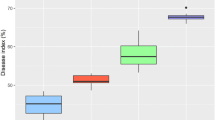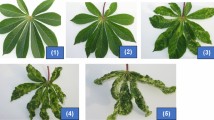Abstract
Breeding for resistant genotypes is the best strategy to offset the destructive effects of cassava mosaic disease (CMD) and cassava bacterial blight (CBB). Two sets of diallel parents were selected for the forest and the savannah ecological zones in Ghana based on good levels of resistance to CMD and CBB. Both sets were crossed in a half-diallel design. The first set of seven progenitors and their 21 F1 progenies were planted in a randomised complete block design (RCBD) with three replications in two different locations for two seasons in the forest ecology. The second set of five progenitors and their 10 F1 progenies were planted in a RCBD with three replications in two locations in the coastal savannah ecological zone of Ghana. Both experiments were evaluated for CMD and CBB resistance, fresh root yield, dry root yield, root number, harvest index, dry matter content, plant height at maturity and height at first branching, levels of branching and plant vigour. Results of the combined analysis of variance revealed that the environment effect was significant for all the traits. General combining ability and specific combining ability effects were significant for most of the traits. Narrow sense heritability was significant for plant vigour, root number, CMD and CBB in both the zones. CMD and root number also had a predictability ratio of close to one, indicating the importance of additive gene effects.
Similar content being viewed by others
References
Baker RJ (1978) Issues in diallel analysis. Crop Sci 18:533–536
Beil GM, Atkins RE (1967) Estimates of general and specific combining ability in F1 hybrids for grain yield and its components in grain sorghum (Sorghum vulgare). Pers. Crop Sci 7:225–228
Bhateria S, Sood SP, Panthania A (2006) Genetic analysis of quantitative traits across environments in linseed (Linum usitatissimum L.). Euphytica 150:185–194
Ceccarelli S (1994) Specific adaption and breeding for marginal condition. Euphytica 77:205–219
CIAT (2003) Project IP3: improved cassava for the developing world. Annual report. Cali, Colombia
Dudley JW, Moll RH (1969) Interpretation and use of estimates of heritability and genetic variance in plant breeding. Crop Sci 9:257–262
FAO (2009) www.fao.org/docrep/012/ak341e/ak341e06.htm. Accessed 15 Nov 2012
Griffing B (1956) Concept of general and specific combining ability in relation to diallel crossing system. Aust J Exp Biol Med Sci 9:463–493
Haussmann BIG, Obilana AB, Blum AP, Ayiecho O, Schipprack W, Geiger HH (1999) Quantitative- genetic parameters of sorghum (Sorghum bicolor (L.) Moench) grown in semi-arid areas of Kenya. Euphytica 105:109–111
Hillocks RJ, Jennings DL (2003) Cassava brown streak disease: a review of present knowledge and research needs. Int J Pest Manag 49:225–234
IITA (1990) Cassava in tropical Africa, a reference manual. IITA, Ibadan
Jaramillo G, Morante N, Perez JC, Calle F, Ceballos H, Arias B, Bellotti AC (2005) Diallel analysis in cassava adapted to the mid altitude valleys environments. Crop Sci 45:1058–1063
Jennings DL (1994) Breeding for resistance to African cassava mosaic geminivirus in East Africa. Trop Sci 34:110–122
Kawano K (1980) Cassava. In: Fehr WR, Hadley HH (eds) Hybridisation of crop plants. ASA, CSSA, Madison, pp 225–233
Kawano K, Narintaraporn K, Narintaraporn P, Sarakarn S, Limsila J, Suparhan D, Sarawat V, Watananonta W (1998) Yield improvement in a multistage breeding program for cassava. Crop Sci 38:325–332
Muimba-Kankolongo, Phuti K (1987) Relationship of cassava mosaic severity in planting material to mosaic development, growth and yield of cassava in Zaire. Exp Agric 23:221–225
Ntawuruhunga P, Dixon AGO (2010) Quantitative variation and interrelatiohip between factors influencing cassava yield. J Appl Biosci 26:1594–1602
Nweke FI, Dutan S, Spencer C, Lynam John K (2002) The cassava transformation: Africa’s best kept secret. Michigan State University Press, Laing
Ojulong HF (2006) Quantitative and molecular analysis of agronomic traits in cassava (Manihot esculenta Crantz). PhD Thesis. Department of Plant Sciences: Plant Breeding, University of the Free State, South Africa
SAS Institute Inc (2004) JMP (version 8). SAS It. Inc, Cary
Singh RK, Chaudhary BD (1979) Biometrical methods in quantitative genetic analysis. Kalyani Publishers, New Delhi
Ssemakula G, Dixon AGO (2007) Genotype × environment interaction, stability and agronomic performance of carotenoid-rich cassava clones. Sci Res Essay 2:390–399
Thresh JM, Otim-Nape GW, Legg JP, Fargette D (1997) African cassava mosaic virus disease: the magnitude of the problem. Afr J Root Tuber Crops 2:13–19
Author information
Authors and Affiliations
Corresponding author
Rights and permissions
About this article
Cite this article
Parkes, E.Y., Fregene, M., Dixon, A. et al. Combining ability of cassava genotypes for cassava mosaic disease and cassava bacterial blight, yield and its related components in two ecological zones in Ghana. Euphytica 194, 13–24 (2013). https://doi.org/10.1007/s10681-013-0936-9
Received:
Accepted:
Published:
Issue Date:
DOI: https://doi.org/10.1007/s10681-013-0936-9




